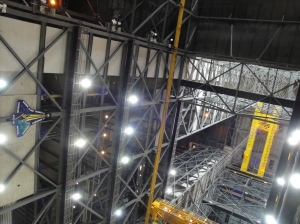
On Monday the media center was empty and the KSC media staff said they were glad to see the media back. It has been so lonely without us. Maybe, maybe not. With only an exception or two the NASA KSC pr staff is terrific to deal with.
.
INDEX to MEDIA EVENTS
Launch-minus-Four-Days L-4, Monday November 21, 2011
FIRST ===
11 am RADIOLOGICAL CONTROL CENTER (RADCC)
Safety procedures for the Mars Science Laboratory’s (MSL) Multi-Mission Radioisotope Thermoelectric Generator (MMRTG)
SECOND ===
1 pm WHAT DO WE KNOW ABOUT MARS?
Michael Meyer, lead scientist Mars Exploration Program
John Grotzinger, project scientist, MSL, California Institute of Technology
Bethany Ehlmann, scientist, Jet Propulsion Laboratory (JPL), assistant professor, California Institute of Technology
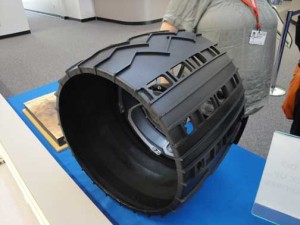
Example of a wheel from the MSL (MSL has six) in the Media Center at KSC. The rover was designed in Pasadena, CA, at the Jet Propulsion Laboratory. JPL was so proud they put their name on the tire (like Firestone) and were told by a peevish NASA to take their name off. They did, but take a look at those odd holes in the tire. Those holes are Morse Code letters J, P and L.
2:30 pm 21ST CENTURY GROUND SYSTEMS TOUR
visit: Launch Equipment Test Facility
visit: Operations and Checkout Building for Orion Manned Space Capsule
visit: Multi-Payload Processing Facility
visit: Canister Rotation Facility
Five Days to Go: The Countdown begins
The launch of the Mars Science Laboratory, a two-ton rover packed with the ability to conduct scientific experiments is five days away. Thanksgiving is Thursday, so the launch clock will go from L-2 on Wednesday, skip Thursday, and L-1 will be on Friday.
NASA has packed the week with briefings for the media and, when the Tweeters are allowed in on Friday, there will be a bunch more briefings for them.
Sunday night, November 20, 2011
Months ago I requested credentials for the launch, uncertain that I would be in Florida. Most of the fall I have been in Los Angeles or Austin at Red Studios, at the American Film Market and at the Austin Film Festival.
I remembered that the launch was going to be about Thanksgiving. Thanksgiving is next Thursday. I log on to the NASA Media site and download the schedule.
Uh-oh, Briefings begin in the morning.
I ponder this. Carol Anne, who photographs for me, is in Virginia. She will not return until Monday night and I will need to pick her up at the airport in Orlando. I’ve lost her arrival time, but can figure it out. The NASA briefings begin at 11 Monday morning and go most of the day. I need to build in an extra hour to pick up my credentials, a task complicated by NASA sometimes credentialing at the badging office on State Highway 405, and at other times on State Road 3.
Normally a quick call to the NASA Press office tells me where to go. But during the summer my iPhone brunched down my telephone book.
I take a deep breath and bet on the State Road 405 badging office and, bet correctly. But then the badging officer demands that I show her my “Credential Letter” in addition to my passport and my driver’s license. No one has ever asked me to print out the email confirming my accreditation before.
We stare. Isn’t name in the computer? Yes. So am I not accredited? Silent staring. I have not budgeted what will not cost at least another hour, still I have to give up …
“I will go find somewhere and print it out,” I finally say giving up, smiling my aging choir boy smile.
With that she hands me my badge. “Next time,” she says, “have that letter.”
. . . . .
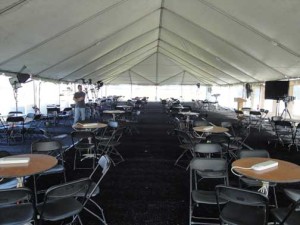
On Monday morning the Tweet tent was ready for the Tweeters, loaded with high tech equipment. But wait -- the Tweeters don't come until Friday because the launch has been pushed back a day. So will all of this expensive stuff sit out here under the sun for most of the week? Apparently so -- a dour guard tells me he has settled in to babysit everything 24/7 until the Tweeters show up.
I sign up for all of the tours for the day and am almost the only one on the list. I banter with Jennifer and Laurel and re-punch the media numbers into my iPhone. The media center is empty.
Will I need to request work space? No. Only 178 media are accredited and half or more will not show up. This means that this time Tweeters, at 150, will almost match the number of media.
I have a list of access requests and discuss them. I am told with a single exception fulfilling them should be no problem. I’m given the contacts and the email addresses. Will it really be this easy now that 90-percent of the media is gone and we’re back to un-manned missions where human life is no longer at stake?
It sure looks like it.
11 am The KSC Radiological Control Center (RADCC)
The Mars Science Laboratory carries is powered by uranium. If that canister of uranium is ruptured on launch, it could contaminate a wide area around the launch site.
NASA this morning wants the media to see the precautions they are taking, and to see an example of the canister itself. First we visit the Radiological Control Center which monitors more than one hundred radiation devices in a huge swatch of central Florida. Then we are tasken into a separate control room which, in the event of an accident, will be responsible for informing the media.
It’s very convincing. These guys cannot afford an accident, especially one that radiates central Florida. It ain’t gonna happen (and on Saturday, it doesn’t).
.

Lots of stuff is in the same building as the Radiological Control Center, including a dorm of the third floor for the astronauts.
.

The media was welcomed and greeted in the foyer before going upstairs to the control rooms. NASA is very sensitive that any danger issues be addressed and answered.
.

Example of one of several different radiological monitoring devices NASA placed in large numbers over a huge swatch of central Florida. These devices are sending data constantly and are being monitored in the Radiological Control Center constantly during and following launch.
.
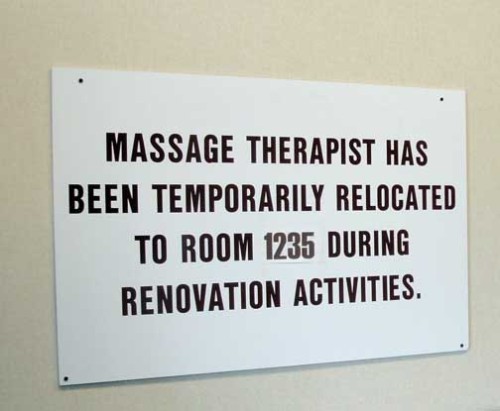
Many of the facilities at Kennedy Space Center are now being re-purposed with the end of the Space Shuttle program. Feeling tension and need a massage? The massage therapist has moved. This sign is prominent in the foyer of the building where the Radiological Control Center is located.
.

If something bad happens during launch (and it never has) these guys would know first. The remote monitoring devices are reporting constantly to these monitors.
.
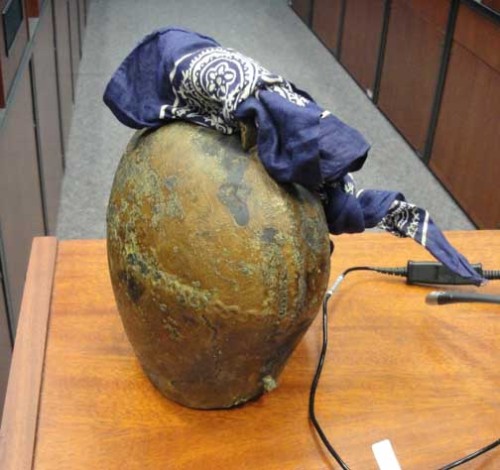
The Cowbell. This is a busy and not always quiet room. If something bad happens or if the attention of everyone in the room is required, CLANG, CLANG, CLANG the cowbell is used. The bell was demonstrated for the unruly media and is quite convincing. My ears are still ringing. Moo.
.

Department of Energy official explains how the MSL is powered, and why the uranium in the MSL can be launched safely. Later in the week he told me that the MSL will have power to operate as long as 14 years, long after the MSL is expected to be operations on the surface of Mars.
.

MSL's power source. Small but powerful and so completely sealed that all efforts to smash the capsule and expose the uranium failed. They figured out how to seal it up; they never managed to bust it open. Nonetheless, a large operation stands by in the Radiological Control Center should the capsule rupture and scatter uranium.
.
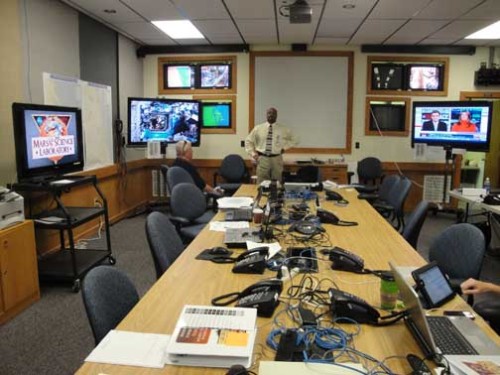
This is the press room where, should there be a radiological danger after launch of the MSL, the press and public will be informed. Big operation. Never been needed.
.

Pride in NASA, and pride in the accomplishments of the American space program are everywhere, even as these offices empty out and people lose their jobs. The shuttle is gone and the future of the United States in space, while not tenuous, is not as robust as it once was when we were launching humans into space.
.

Michael Meyer (second from left), Bethany Ehlmann (second from right) and John Grotzinger (far right) spent an hour in early afternoon discussing "What do we know about Mars?" The answer is, a lot, including that water appears to be trapped there and while it is not conclusive that life ever existed on Mars, there's growing suspicion that it may have, and may still. Meyer is the lead scientist on the Mars Exploration Program. Ehlmann is a scientist at the Jet Propulsion Laboratory and an assistant professor at California Institute of Technology. Grotzinger is project scientist, Mars Science Laboratory and California Institue of Technology. NASA has moderators (far left) for all conferences, usually drawn from their public relations staffs.
.

KSC Launch Equipment Test Facility is a rarely seen place because testing is often going on here, and testing can be hazardous. These days the facility has many fewer people, including only one remaining government NASA employee.
.

Tests are carefully studied and controlled from this room. This is the Control Room in the Launch Equipment Test Facility.
.
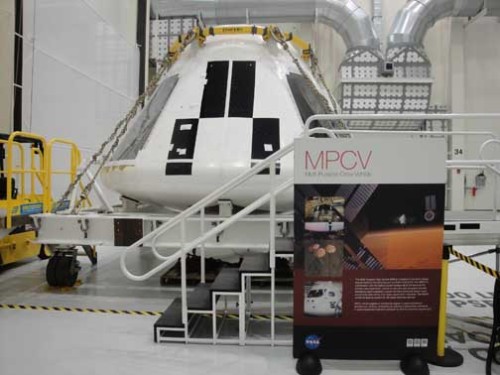
Orion, which looks like an Apollo capsule on sterioids, is supposed to be the next generation NASA space vehicle. As with Apollo, this vehicle is meant to travel deeper into space than low earth orbit where the shuttle and the International Space Station traveled. It is hoped that Orion can land on an asteroid, the Moon or even Mars. Until late 2012 it was, however, a capsule without a rocket or a mission. This building is known officially as "The Checkout Building for Orion" and has been extensively repurposed for its earlier uses.
.

The shuttle;s Canister Rotation Facility now houses the Orion escape mechanism. After the deaths of the Columbia astronauts on STS-107 great re-design effort was put into affording future astronauts more opportunities to survive. How to escape and survive an accident involving Orion is being studied in this building.
.

The escape mechanism would pull the Orion capsule away from the rocket and allow it to land by parachute on water or land. Escaping quickly enough is no simple matter either technologically, or for the astronauts themselves. The G-force required to escape is 15 Gs, a gravity force that the human body can only endure about three seconds. By contrast Apollo subjected Astronauts to 6-Gs and the Shuttle to 3-Gs.
. . . . . . . . . . . . . . .
 .
.
.
.”petecrow/NASA” © 2011 by / Peter M. Crow and the Peter Michael Crow Trust and by Seine/Harbour® Productions, LLC, Studio City, California.


